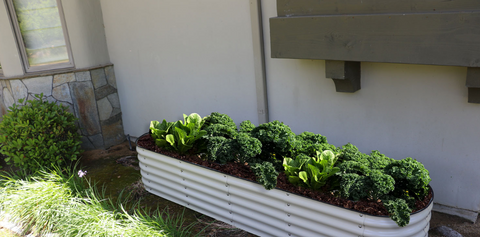Tips from Olle Garden Bed: How Beneficial Are Garden Plants to Us
We use garden beds to grow plants. How much benefit do these plants actually contribute to human society? Let's take stock.

1. Carbon fixation and oxygen release
When it comes to plants, the first thing that comes to mind is photosynthesis: by absorbing light energy, green plants can convert carbon dioxide and water into energy-rich organic matter, while releasing oxygen. In other words, as plants grow, they are able to keep carbon dioxide from the atmosphere in their bodies and increase the amount of oxygen in the atmosphere. Generally, plants with high carbon sequestration will have relatively high oxygen release. According to the survey, the trees with high ability are black locust, elm, sugar maple, yellow oak, weeping willow, red steppe, red plum so on.
2. Add negative air ions
Negative air ions can not only purify the air, but also have obvious health care effect on the human body. The fresh air produced by plant photosynthesis is one of the main sources of negative air ions. According to the research results, the air negative ion content of pine, Chinese fir and cypress plants is usually higher, such as, Chinese fir, Masson's pine.
3. Catch dust
Industrial production and urban life cause the increase of dust, smoke and harmful gases in the air, which have a great impact on people's physical and mental health. Plants play an irreplaceable role in improving these problems. The luxuriant canopy of plants, especially woody plants, can reduce wind speed, making large particles of dust carried in the air sink to the leaves or ground of trees with the decrease of wind speed. At the same time, the leaf surface of plants can absorb a large amount of dust and drifting dust, and do repeated work through rain erosion. However, the dust retention of different species was different, and the roughness of leaves and the shape and quantity of upper and lower surface fur were the main reasons for the difference. According to the survey, the trees with good dust catching effect are red spruce, juniper, silver Chinese poplar, peach plum, honeysuckle and so on.
4. Cool and humidify
Through transpiration, plants can take away a lot of heat from the environment, and at the same time play a role in cooling and humidifying. In addition, the large amount of oxygen released by plants also helps to mitigate the greenhouse effect.
5. Absorb harmful substances
Plants can absorb and degrade pollutants in the atmosphere, so that the atmosphere can be purified, to avoid human harm. According to the research, the plants with high lead absorption amount are mulberry, golden tree, elm, dry willow, catalpa, etc. The cadmium absorption was higher in poplar, mulberry, elm, catalpa, etc. The higher sulfur absorption capacity were cottonwood, villus ash, etc.; High chlorine absorption of elm, peach, white poplar, maple poplar, , euonymus, jujube and so on; The fluorine absorption amount is higher elm, villous ash, etc..

6. Noise reduction
There is a lot of noisy noise in the city, which is easy to make people upset, fidgeting, and by planting green plants around the area of daily activities, can play a role in reducing the noise effect. In general, dense foliage trees, the noise reduction result is better, such as the coral tree, oleander, heather, safflower ð ª squared wood, Sabina snow
7. Bactericidal and bactericidal
On the one hand, green plants can make bacteria lose the breeding place by absorbing dust in the air. On the other hand, the gas released by some plants with health functions has the ability to kill bacteria and fungi, which can play a similar role of anti-inflammatory. Representative plants are bamboo, ivy, begonia, pine, cypress, cloves and so on.
In addition, the volatile substances of many health plants also have the function of inhibiting and killing different bacteria.
8. Reduce UV damage
Due to the destruction of the ozone layer in the atmosphere, the intensity of ultraviolet radiation is gradually increasing. When people are exposed to ultraviolet light for a long time, it will not only cause skin damage and lesions, but also cause a lot of harm to the eyes. However, the leaf surface of green plants can reflect and absorb most ultraviolet rays, especially the tree species with large crown width, small leaf Angle and large leaf area have better isolation effect on ultraviolet rays.
9. Deworming
Many plant volatiles can also repel mosquito flies or pests, such as camphor aroma can repel mosquitoes. The volatiles of peppermint, lavender, basil, fennel, vanilla, rosemary, night tree, cinnamon and other plants can repel flies and insects. They are non-toxic, pollution-free and non-residual natural insect repellents. Bay leaves can repel weevils; Vanilla repels tea plant pests...

In addition, many health care plants also have the functions of promoting cardiovascular system circulation, regulating nerves and promoting human metabolism. They have corresponding plant groups suitable for people of different ages. Human health care through plants is gradually attracting more scholars' attention and will be more widely used in the future.
